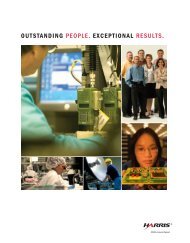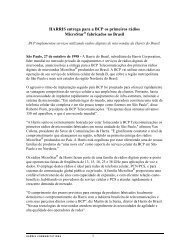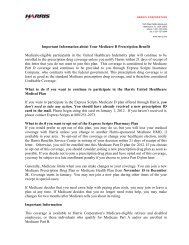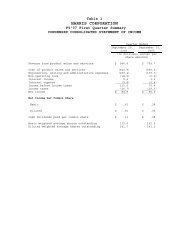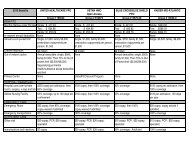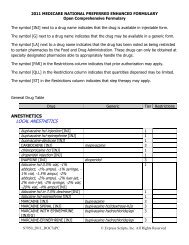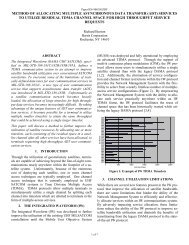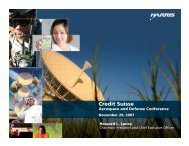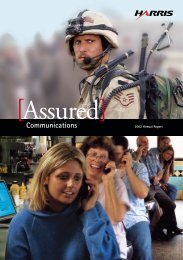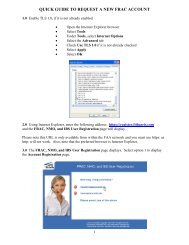harris corporation
harris corporation
harris corporation
You also want an ePaper? Increase the reach of your titles
YUMPU automatically turns print PDFs into web optimized ePapers that Google loves.
NOTES TO CONSOLIDATED FINANCIAL STATEMENTS (Continued)<br />
and 7 years. See Note 7: Property, Plant and Equipment for additional information regarding property, plant and<br />
equipment.<br />
Goodwill and Indefinite-Lived Intangible Assets — Goodwill and indefinite-lived intangible assets are not<br />
amortized. We perform annual (or under certain circumstances, more frequent) impairment tests of our goodwill and<br />
indefinite-lived intangible assets. We test indefinite-lived intangible assets for impairment by comparing their fair<br />
value (determined by forecasting future cash flows) against their carrying value. We test goodwill for impairment<br />
using a two-step process. The first step is to identify potential impairment by comparing the fair value of each of<br />
our reporting units with its net book value, including goodwill, adjusted for allocations of corporate assets and<br />
liabilities as appropriate. If the fair value of a reporting unit exceeds its adjusted net book value, goodwill of the<br />
reporting unit is considered not impaired and the second step of the impairment test is unnecessary. If the adjusted<br />
net book value of a reporting unit exceeds its fair value, the second step of the goodwill impairment test compares<br />
the implied fair value of the reporting unit’s goodwill with the carrying amount of that goodwill. If the carrying<br />
amount of the reporting unit’s goodwill exceeds the implied fair value of that goodwill, an impairment loss is<br />
recognized in an amount equal to that excess. The implied fair value of goodwill is determined in the same manner<br />
as the amount of goodwill recognized in a business combination. The fair value of the reporting unit is allocated to<br />
all of the assets and liabilities of that unit, including any unrecognized intangible assets, as if the reporting unit had<br />
been acquired in a business combination and the fair value of the reporting unit was the purchase price paid to<br />
acquire the reporting unit. See Note 8: Goodwill, Note 9: Intangible Assets and Note 22: Impairment of Goodwill<br />
and Other Long-Lived Assets for additional information regarding goodwill and intangible assets, including goodwill<br />
and intangible asset impairment charges recorded in fiscal 2009.<br />
Long-Lived Assets, Including Finite-Lived Intangible Assets — Long-lived assets, including finite-lived<br />
intangible assets, are amortized on a straight-line basis over their useful lives. We assess the recoverability of the<br />
carrying value of our long-lived assets, including intangible assets with finite useful lives, whenever events or<br />
changes in circumstances indicate the carrying amount of the assets may not be recoverable. We evaluate the<br />
recoverability of such assets based upon the expectations of undiscounted cash flows from such assets. If the sum of<br />
the expected future undiscounted cash flows was less than the carrying amount of the asset, a loss would be<br />
recognized for the difference between the fair value and the carrying amount. See Note 7: Property, Plant and<br />
Equipment, Note 9: Intangible Assets and Note 22: Impairment of Goodwill and Other Long-Lived Assets for<br />
additional information regarding long-lived assets and intangible assets, including impairment charges recorded in<br />
fiscal 2009.<br />
Capitalized Software to Be Sold, Leased or Otherwise Marketed — Costs incurred to acquire or create a<br />
computer software product are expensed when incurred as research and development until technological feasibility<br />
has been established for the product, at which point such costs are capitalized. Technological feasibility is normally<br />
established upon completion of a detailed program design. Capitalization of computer software costs ceases when<br />
the product is available for general release to customers. Costs of reproduction, documentation, training materials,<br />
physical packaging, maintenance and customer support are charged to cost of products sold as incurred. Capitalized<br />
software to be sold, leased or otherwise marketed is evaluated for impairment periodically by comparing the<br />
unamortized capitalized costs of a computer software product to the net realizable value of that product. In the<br />
fourth quarter of fiscal 2009, we recorded a $24.4 million write-down of capitalized software in our Integrated<br />
Network Solutions segment based on market conditions that resulted in reduced levels of capital expenditures,<br />
including demand for Integrated Network Solutions’ software products. See Note 22: Impairment of Goodwill and<br />
Other Long-Lived Assets for additional information regarding impairment charges recorded in fiscal 2009.<br />
Capitalized software to be sold, leased or otherwise marketed had a net carrying value of $36.4 million at<br />
July 1, 2011 and $27.1 million at July 2, 2010. Total amortization expense related to these capitalized software<br />
amounts for fiscal 2011, 2010 and 2009 was $4.5 million, $3.4 million and $4.7 million, respectively. The annual<br />
amortization of these capitalized software costs is the greater of the amount computed using (a) the ratio that current<br />
gross revenues for a product bear to the total of current and anticipated future gross revenues for that product or<br />
(b) the straight-line method over the remaining estimated economic life of the product. Based on this policy, the<br />
useful lives over which we amortize costs of computer software to be sold, leased or otherwise marketed range from<br />
2 to 7 years. Amortization commences when the product is available for general release to customers. The<br />
capitalized costs, net of accumulated amortization, are reflected in the “Other non-current assets” line item in our<br />
Consolidated Balance Sheet. The amortization of capitalized software is included in the “Cost of product sales” line<br />
item in our Consolidated Statement of Income.<br />
67



